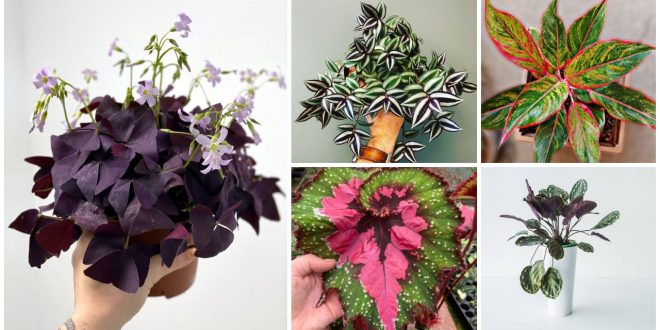
The Finest Forms of Indoor Purple Vegetation to Remodel Your Residing House
Home crops add life, mild, and heat to inside design. Should you’re trying to elevate the visible curiosity of your indoor plant assortment, why not shift from pure-green to purple home crops? Whether or not you choose crops which can be washed in shades of purple, dappled with violet spots, or that bloom with vibrant amethyst-colored flowers, your design can’t go incorrect while you select a purple home plant.
Purple Home Vegetation Meanings & Symbolism
When present in crops and flowers, the colour purple usually represents royalty and custom. Purple can even symbolize success and emotions of admiration.
Particular person purple flowers and crops have additionally taken on their very own symbolic meanings. For instance, the purple lotus represents spirituality in Buddhist traditions, the purple violet represents prayer in Christianity, and the Chinese language evergreen symbolizes good luck.
20 Finest Purple Home Vegetation to Develop at Residence
Right here you’ll discover 20 of our favourite purple home crops that can thrive in a variety of dwelling environments. We’ve included a short care information for every so yow will discover the right decide to your personal distinctive dwelling setting.
1. Prayer Plant (Maranta leuconeura)
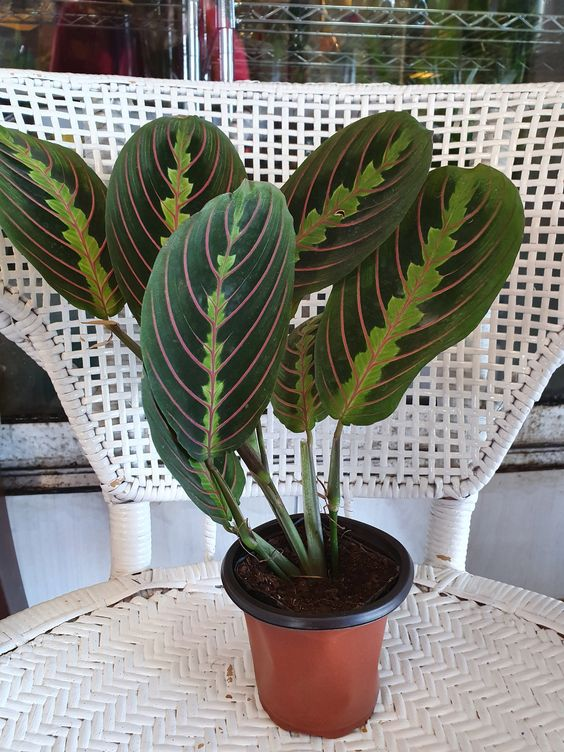
The prayer plant will get its widespread identify from its diurnal rhythm that leads to its leaves mendacity flat through the day and folding upright at evening, as if in prayer for night vespers. Its leaves function putting markings and coloring, which range based mostly on the number of plant.
| GENERAL CARE: | Not too troublesome to develop so long as you meet its explicit wants |
| SOIL: | Moist, well-draining, impartial to acidic soil |
| LIGHT: | A fan of full shade |
| TEMP & HUMIDITY: | 65°F to 85°F and common to excessive humidity |
| WATERING: | Water with filtered water when the soil dries midway |
| FEEDING: | Present half-strength, water-soluble fertilizer each 1 to 2 weeks from early spring via fall |
| GROWTH: | Sluggish rising plant reaches about 1-foot tall and 1-foot broad |
| TOXICITY: | Non-toxic |
2. Wandering Jew (Tradescantia zebrina)
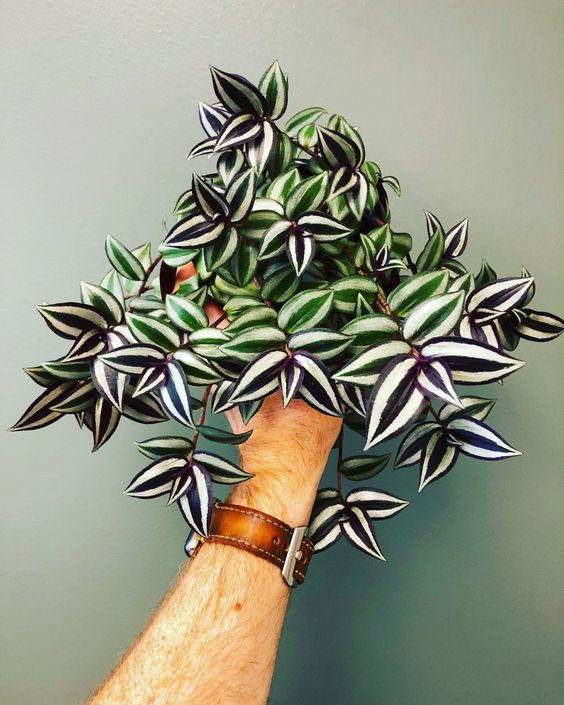
Additionally generally known as the inch plant or spiderwort, the wandering Jew options striped leaves with new progress in a deep-purple hue and older progress in deep inexperienced. It blooms with small, purple flowers. Because it grows in colonies, its outside varieties are sometimes used as floor cowl in outside gardens. Tradescantia zebrina is often potted in hanging containers indoors.
| GENERAL CARE: | Low-maintenance |
| SOIL: | Wealthy, well-draining, loamy soil |
| LIGHT: | Vibrant, oblique daylight |
| TEMP & HUMIDITY: | 50°F to 80°F and common humidity |
| WATERING: | Moist, well-draining, impartial to acidic soil |
| FEEDING: | Half-strength, water-soluble fertilizer as soon as a month |
| GROWTH: | Quick-growing reaches about 6 to 12 inches in top and as much as 24 inches in size. |
| TOXICITY: | Non-toxic |
3. Rex Begonia (Begonia rex-cultorum)


Generally known as fancy-leaf begonias or painted-leaf begonias, Rex Begonia crops are well known for his or her extremely decorative foliage which options fascinating patterns of intertwining fuchsia, silver, eggplant, crimson, and deep inexperienced.
| GENERAL CARE: | Cautious cultivation is important to producing enticing foliage. |
| SOIL: | Properly-draining, porous potting combine |
| LIGHT: | Full to partial shade |
| TEMP & HUMIDITY: | Reasonable humidity (about 50%) and temperatures between 60°F to 70°F |
| WATERING: | Common watering to take care of moist however by no means soggy soil |
| FEEDING: | Half-strength, water-soluble fertilizer each two weeks |
| GROWTH: | Reaches about 12 to 18-inches tall and broad |
| TOXICITY: | Poisonous to people, canines, and cats |
4. Chinese language Evergreens (Aglaonema)

Chinese language evergreens are thought to deliver luck and have been cultivated for hundreds of years in Asia because of this. They’re a stunning indoor plant with superbly marked foliage and perennial blossoms in mature crops.
| GENERAL CARE: | Tough to develop in particularly arid environments |
| SOIL: | Peaty, acidic, well-draining potting combine |
| LIGHT: | A fan of full shade |
| TEMP & HUMIDITY: | Temperatures above 65°F and excessive humidity. Mist continuously or add a humidifier. |
| WATERING: | Prefers moist however not soggy soil. Look forward to the soil to dry earlier than watering (and draining) totally. |
| FEEDING: | Feed as soon as in early spring and as soon as in late summer time with slow-release fertilizer pellets. |
| GROWTH: | Sluggish-growing as much as 2-feet tall and broad |
| TOXICITY: | Poisonous to individuals, canines, and cats |
5. Calatheas (Calathea)

Calathea is a genus containing dozens of species of leafy inexperienced crops. These crops are often known as calatheas and generally they’re known as prayer-plants, like their shut cousins Maranta leuconeura. Calathea leaves resemble carved feathers with eye-catching angular markings and a pinnate form.
| GENERAL CARE: | Straightforward to develop, low-maintenance |
| SOIL: | Porous, well-draining soil |
| LIGHT: | Medium to vibrant oblique daylight |
| TEMP & HUMIDITY: | 65°F to 85°F and reasonable to excessive humidity |
| WATERING: | Water when the soil dries midway (each 1 or 2 weeks) |
| FEEDING: | Feed month-to-month in spring and summer time solely with a general-purpose fertilizer. |
| GROWTH: | Sluggish to reasonable progress. Reaches about 2 toes in top indoors. |
| TOXICITY: | Non-toxic |
6. Purple Shamrock (Oxalis triangularis)

Generally known as the false shamrock or purple shamrock, Oxalis triangularis is definitely native to South America – not Eire – though they’re popularly bought round Saint Patrick’s Day. These purple home crops resemble their wooden sorrel kinfolk with inexperienced foliage and white flowers, however the purple shamrock truly grows dark-purple foliage and white, pink, or lavender flowers.
| GENERAL CARE: | Low-maintenance, simple to develop |
| SOIL: | Properly-draining, loamy, sandy, acidic soil |
| LIGHT: | Full to partial daylight |
| TEMP & HUMIDITY: | Reasonable humidity and temperatures between 60°F and 75°F |
| WATERING: | Prefers even moisture. Water when the highest inch of soil is dry. |
| FEEDING: | Fall, winter, and spring solely fertilize with a slow-release fertilizer |
| GROWTH: | As much as 1-foot tall and 2-feet broad |
| TOXICITY: | Poisonous to individuals, canines, and cats |
7. Cyclamen
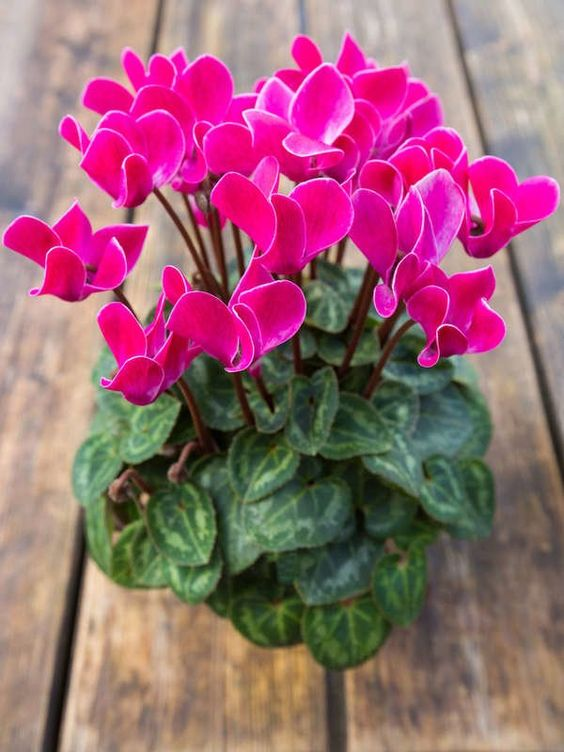
Native to the Mediterranean Basin, Cyclamen is a genus of 23 flowering crops. They’ve attractively dappled heart-shaped leaves which can be inexperienced on the highest and purple on the bottom. Their shooting-star-shaped flowers blossom from fall via spring in pretty purple, pink, crimson, and white hues.
| GENERAL CARE: | Straightforward to take care of and low-maintenance. Do not forget that cyclamens look lifeless when dormant. |
| SOIL: | Loamy, well-draining, acidic soil |
| LIGHT: | Partial solar or vibrant, oblique mild |
| TEMP & HUMIDITY: | Excessive humidity. Nighttime temperatures between 40°F and 50°F. Daytime temperatures between 60°F and 75°F. |
| WATERING: | Choose even moisture. Water totally and permit extra moisture to empty when the highest inch of soil is dry. |
| FEEDING: | Fall, winter, and spring solely feed with half-strength, low-nitrogen fertilizer. |
| GROWTH: | 6 to 9-inches tall |
| TOXICITY: | Poisonous to individuals, canines, and cats |
8. Purple Vanda Orchid (Vanda)
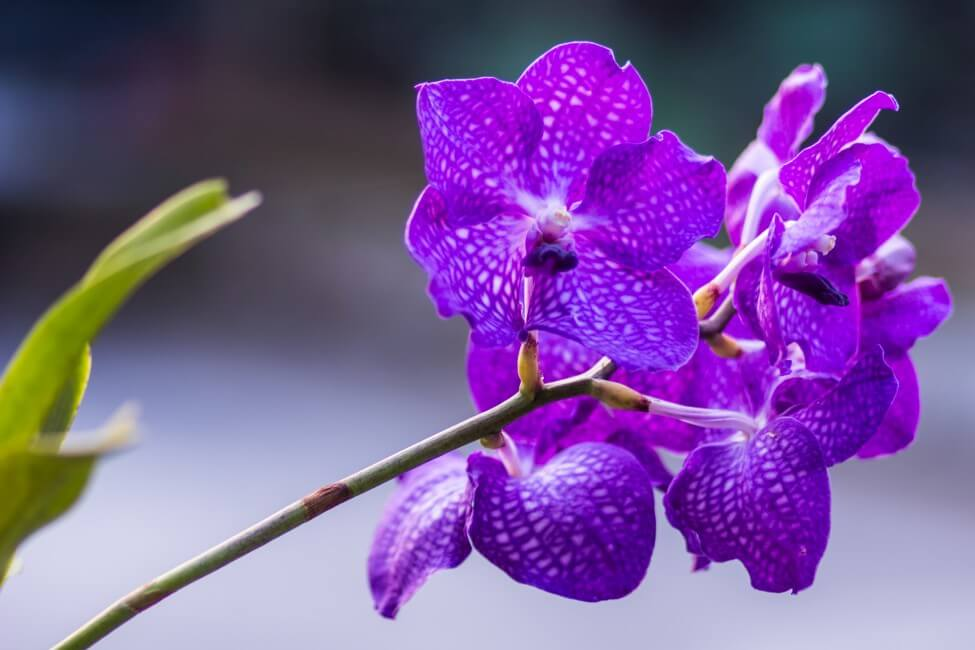
Vanda is a genus of about 80 species of orchids which have gorgeous blossoms in nearly all colours of the rainbow. A number of species of vanda orchids – like Vanda coerulea, Vanda pachara, Vanda sansai blue, Vanda mokara, and Vanda Robert’s delight to call only a few – bloom with aromatic stalks of speckled flowers spanning violet and indigo hues which make them fairly putting purple home crops to introduce at house.
| GENERAL CARE: | Pretty high-maintenance, however simple to develop in the correct circumstances. |
| SOIL: | Impartial, well-draining, soilless bark or peat moss |
| LIGHT: | Partial solar or vibrant, oblique daylight |
| TEMP & HUMIDITY: | Excessive humidity (mist continuously) and temperatures between 65°F and 85°F |
| WATERING: | Excessive water wants. Water continuously, however at all times enable to empty utterly. |
| FEEDING: | Fertilize weekly in spring and summer time and month-to-month in fall and winter with a balanced fertilizer. |
| GROWTH: | Mature crops attain 1 to 3-feet tall |
| TOXICITY: | Thought-about non-toxic, however be cautious with youngsters and pets, because the toxicity profile of all cultivars and hybrids is unclear. |
9. Persian Defend Plant (Strobilanthes dyeriana)

The Persian protect is an evergreen shrub native to Myanmar. It has lush, inexperienced foliage topped with pinwheels of metallic leaves in a shade of purple that resembles the colour of a peacock’s feathers. In the correct circumstances, Persian shields additionally produce lavender-colored flowers, however blooming is uncommon for indoor crops.
| GENERAL CARE: | Low-maintenance |
| SOIL: | Barely acidic to impartial, wealthy, moist, well-draining soil |
| LIGHT: | Partial shade |
| TEMP & HUMIDITY: | Reasonable to excessive humidity at temperatures above 60°F |
| WATERING: | Water when the highest inch of soil dries with filtered room-temperature/luke-warm water. |
| FEEDING: | In wealthy soil feed solely as soon as in early spring and as soon as half-way via summer time with an all-purpose fertilizer |
| GROWTH: | Mature crops attain about 3 to 4-feet tall. |
| TOXICITY: | Non-toxic to individuals and pets. Sap could cause gentle pores and skin irritation. |
10. Christmas Cactus (Schlumbergera)
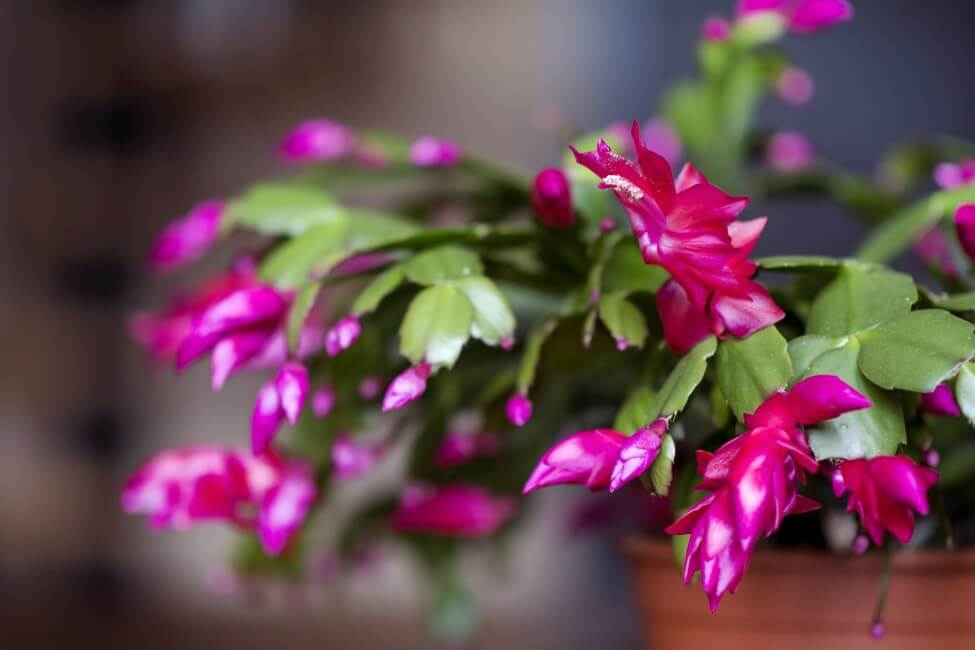
Though categorized as a cactus, Schlumbergera is a genus of crops which can be native to the coastal mountains of Brazil. Like orchids, they develop from the bark of bushes and in rocky outcroppings. They’ve fascinating segments of pad-like “leaves” and blossom with stunningly intricate tubular flowers in a wide range of colours together with a purplish fuchsia.
| GENERAL CARE: | Straightforward to develop, low-maintenance |
| SOIL: | Impartial to acidic, moist, well-draining soil |
| LIGHT: | Partial solar or vibrant, filtered mild |
| TEMP & HUMIDITY: | Excessive humidity and temperatures from 60°F to 80°F |
| WATERING: | When soil is nearly dry, water totally and permit extra moisture to empty. |
| FEEDING: | Feed month-to-month with a half-strength, water-soluble fertilizer till buds type. Resume month-to-month fertilizer as soon as blossoms emerge. |
| GROWTH: | Reaches as much as 1-foot tall and 2-feet broad |
| TOXICITY: | Non-toxic to individuals and pets |
11. Purple Succulents (Echeveria)

Echeveria is a genus of about 150 species of rosette-shaped succulents which can be native to Mexico, Central America, and Northwestern South America. Relying on the precise species, echeveria crops range in colour, leaf form, dimension, and texture, however they’re all equally stunning and enjoyable to gather. Purple varieties just like the Purple Pearl, Afterglow, Darkish Moon, and Darkish Prince echeverias vary from a dusty lavender hue to a darkish, almost-black purple.
| GENERAL CARE: | Low-maintenance, simple to develop |
| SOIL: | Properly-draining, impartial soil (commonplace cactus and succulent potting combine works nicely) |
| LIGHT: | Full solar (vibrant, direct mild) |
| TEMP & HUMIDITY: | Low humidity and heat temperatures are excellent. Will thrive within the common family, however gained’t survive steamy loos. |
| WATERING: | Low water wants. Solely water when the soil has dried utterly and permit all extra moisture to empty. |
| FEEDING: | Tailored to nutrient-poor soil. Watch out to not over-feed. Solely provide a cactus/succulent fertilizer yearly in spring or summer time. |
| GROWTH: | Measurement varies with species. Some stay low to the bottom and only a few inches throughout, whereas different species develop on tall stalks and develop into fairly giant. |
| TOXICITY: | Non-toxic to pets and folks |
12. Gloxinia
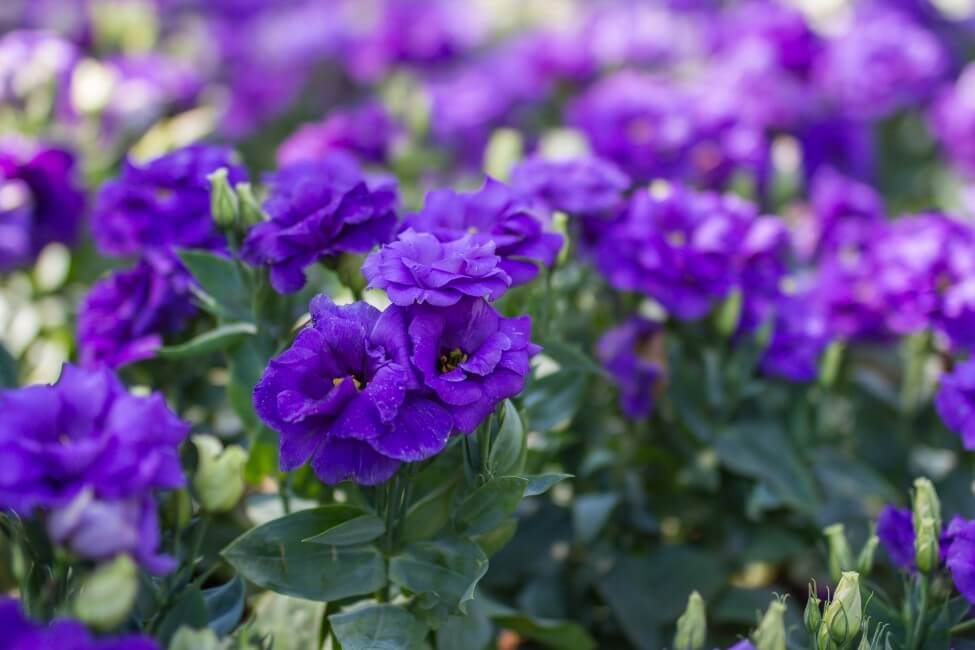
Gloxinia is a genus of simply three authentic species and several other hybrids of flowering crops which can be native to areas of South America together with the Andes, the West Indies, and elements of Central America. This tropical herbaceous plant has lush, inexperienced, spade-shaped foliage and delicate bell-shaped blossoms in shades of lavender and violet. With velvety foliage and showy blooms, gloxinia hybrids are sometimes mistaken for African Violets.
| GENERAL CARE: | Low-maintenance and simple to develop in the correct circumstances |
| SOIL: | Loos, barely acidic, well-draining soil (African violet or gardenia potting combine works nicely) |
| LIGHT: | Vibrant, oblique mild |
| TEMP & HUMIDITY: | Reasonable to excessive humidity and temperatures between 70°F to 80°F |
| WATERING: | Soil ought to at all times be moist however by no means soggy. Self-watering containers are excellent. |
| FEEDING: | Fertilize month-to-month through the rising season with a water-soluble fertilizer. |
| GROWTH: | mature crops attain 6 to 12-inches tall |
| TOXICITY: | Non-toxic to pets and folks |
13. Rubber Tree Plant (Ficus elastica)
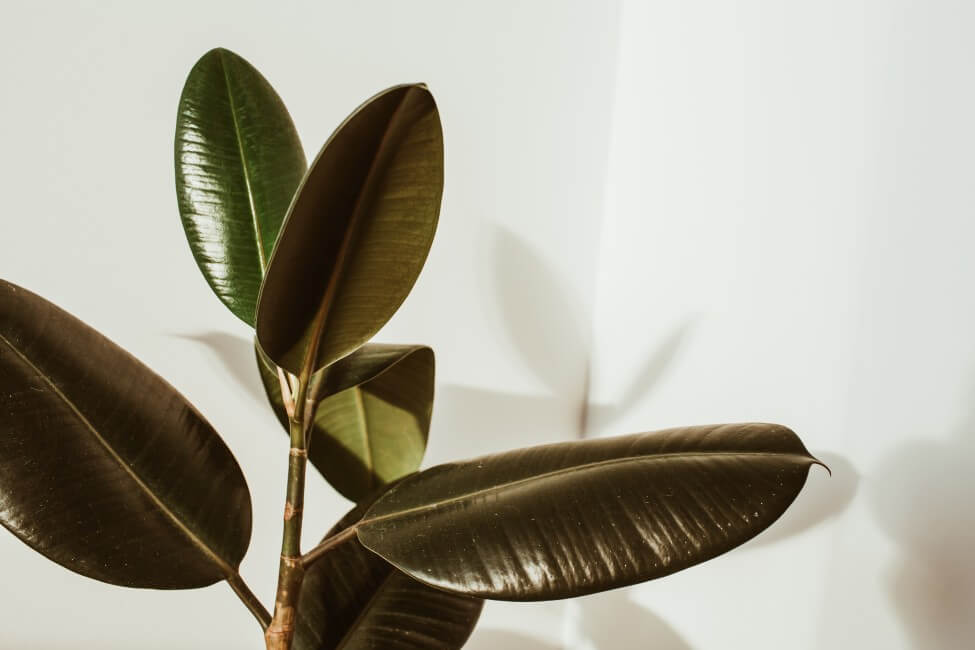
The rubber tree plant is definitely a sort of ficus tree that may develop as much as 200-feet tall in its native habitat, however don’t fear – your rubber tree gained’t develop that massive when potted indoors. Rubber tree crops have enticing, oval-shaped leaves that fan out in a neat sample up the plant’s central trunk. The leaves are a lush-green colour that takes on a purplish hue when seen from under.
| GENERAL CARE: | Straightforward to take care of and low-maintenance |
| SOIL: | Acidic, well-draining soil |
| LIGHT: | Filtered daylight or partial shade |
| TEMP & HUMIDITY: | Reasonable to excessive humidity and temperatures between 60°F and 75°F |
| WATERING: | Choose even moisture. Water totally when the highest inch of soil is dry and permit extra moisture to empty utterly. |
| FEEDING: | Fertilize evenly through the rising season with a half or quarter-strength liquid fertilizer |
| GROWTH: | Indoors rubber bushes can attain as much as 10-feet tall. Management progress with restricted container dimension and light-weight feeding. |
| TOXICITY: | Poisonous to canines and cats. May cause pores and skin irritation in individuals. |
14. Moses-in-the-Cradle (Tradescantia spathacea)
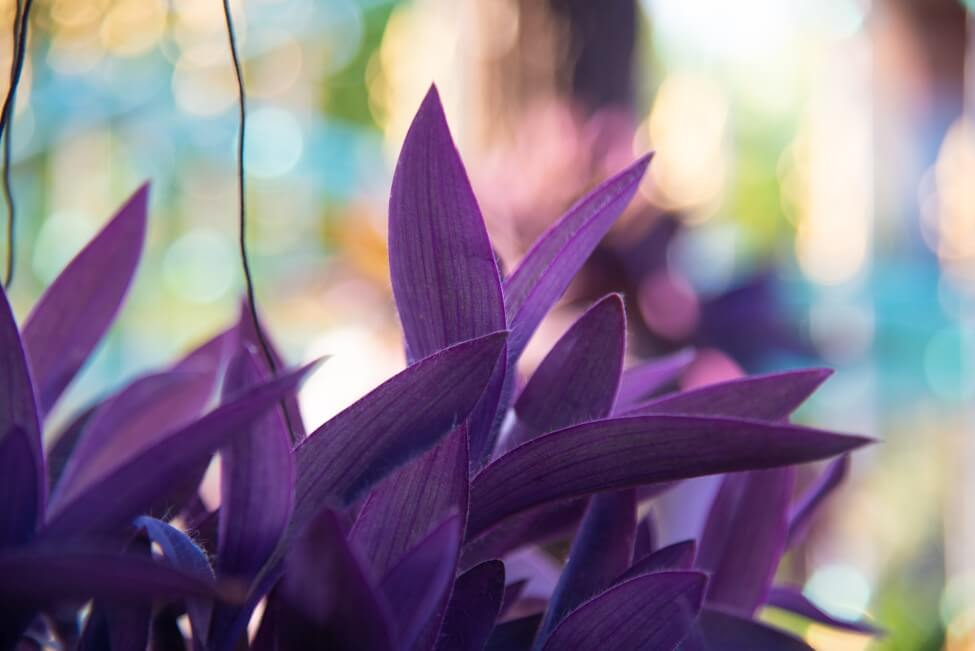
The Moses-in-the-Cradle (additionally known as the boat lily) is a plant that includes a rosette of lance-shaped leaves which can be inexperienced and white striped on the top-side and flash with a vibrant purple on the again. They bloom with clusters of small pink or white flowers. Whereas they develop wildly outdoor in hotter climates and have develop into an invasive species in Florida and Louisiana, they’re fairly popularly cultivated indoors as houseplants.
| GENERAL CARE: | Straightforward, low-maintenance |
| SOIL: | Porous, well-draining soil |
| LIGHT: | Vibrant, direct mild |
| TEMP & HUMIDITY: | 60°F to 85°F and excessive humidity |
| WATERING: | Prefers even moisture. Water when the highest inch or two of soil dries. Cut back watering frequency through the winter. |
| FEEDING: | Spring and summer time solely feed a well-balanced, half-strength fertilizer month-to-month |
| GROWTH: | Reaches about 1 to 2 toes in top and the same diameter |
| TOXICITY: | Poisonous to individuals and pets |
15. African Violet (Streptocarpus sect. Saintpaulia)
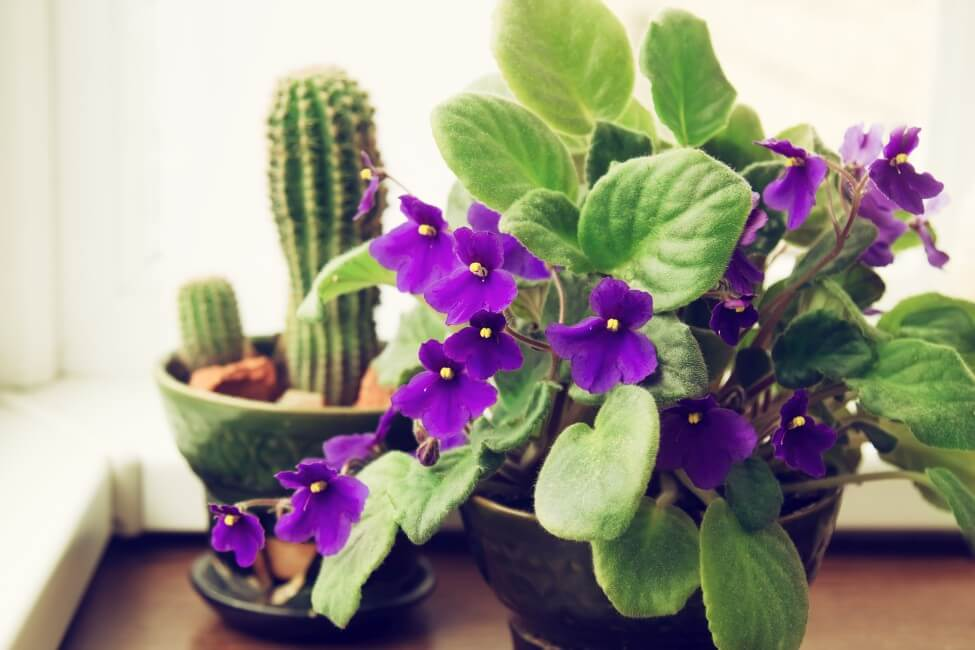
Native to the tropical climates of Japanese Africa, African violets have a status for being troublesome to develop. In the correct circumstances, nonetheless, these crops will thrive and bloom on and off all year long. These crops function a wide range of lush leaves that develop in shades of inexperienced and purple and blossoms that bloom in a wide range of colours and variegations, together with a number of in numerous shades of purple. When you get the grasp of rising African violets, you’ll by no means wish to cease.
| GENERAL CARE: | Reasonable issue however simple to develop in the correct circumstances |
| SOIL: | Barely acidic, nearly impartial pH potting combine that’s porous and well-draining (African violet potting combine is advisable) |
| LIGHT: | Vibrant, oblique daylight |
| TEMP & HUMIDITY: | Excessive humidity and a mean temperature of 70°F |
| WATERING: | Prefers fixed, even moisture soil however by no means soggy soil. Self-watering containers are finest for attaining correct moisture and humidity and avoiding moisture-related leaf injury. |
| FEEDING: | Each different week, feed a fertilizer formulated particularly for African violets. |
| GROWTH: | Low-growing and compact. Mature crops attain 8 to 16-inches throughout |
| TOXICITY: | Non-toxic to pets and folks |
16. Ti Plant (Cordyline fruticosa)
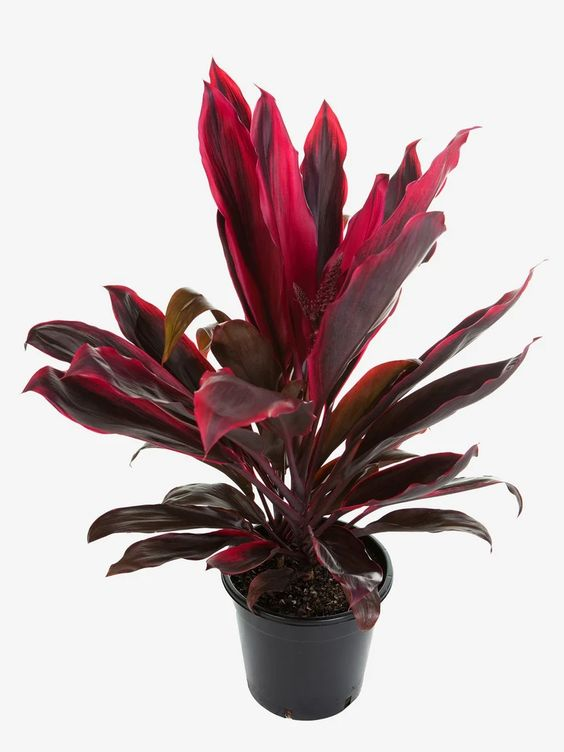
Generally known as the ti plant, Hawaiian ti plant, cabbage palm, or palm lily, the Cardyline fruticosa is native to many islands of the South Pacific, New Zealand, Papua New Guinea, and Southeast Asia. It’s believed to deliver good luck. Plus, it’s grown for non secular and medicinal functions, and it’s beloved around the globe as a houseplant for its enticing, decorative leaves. The ti plant’s sword-shaped leaves sprout upward alongside a central stalk and stun in vibrant shades that vary from fuchsia to a deep purplish-red. It blossoms in shades of lavender, pink, and white.
| GENERAL CARE: | Low-maintenance |
| SOIL: | Barely acidic, loamy/sandy, well-draining potting combine |
| LIGHT: | Full to partial, filtered daylight |
| TEMP & HUMIDITY: | Excessive humidity and temperatures between 65°F and 95°F |
| WATERING: | Water frequently with tepid filtered water through the rising season to take care of constantly moist soil. Keep away from splashing the leaves. Cut back frequency throughout fall and winter. |
| FEEDING: | Feed a slow-release, balanced fertilizer through the rising season. |
| GROWTH: | Mature crops attain as much as 10-feet tall and three to 4-feet throughout. |
| TOXICITY: | Poisonous to pets |
17. Purple Ardour (Gynura aurantiaca)
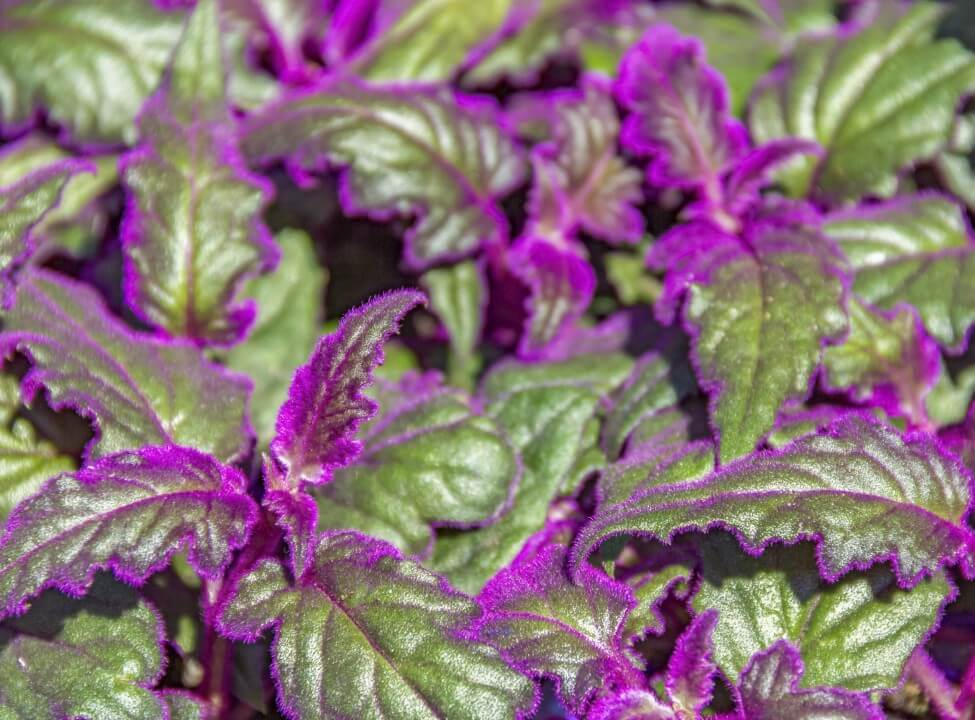
Generally known as the purple ardour or velvet plant, Gynura aurantiaca is a flowering plant that belongs to the daisy household. It’s most famous for its deep-green leaves which can be dusted with a coat of bright-purple fuzz. It options vibrant orange-yellow blossoms and grows wild in Southeast Asia. The plant is straightforward to domesticate indoors in any local weather. Finest displayed in a dangling basket, purple ardour’s lengthy velvety leaves will grasp over the sting.
| GENERAL CARE: | Straightforward, low-maintenance |
| SOIL: | Properly-draining, nutrient-rich soil |
| LIGHT: | Vibrant, oblique/filtered daylight to partial shade (extra daylight creates extra vibrant leaves) |
| TEMP & HUMIDITY: | Reasonable humidity and temperatures from 60°F to 70°F |
| WATERING: | Keep even moisture by watering frequently through the rising season and lowering frequency throughout fall and winter. |
| FEEDING: | Spring and summer time fertilize weekly with a balanced, half-strength, water-soluble fertilizer. |
| GROWTH: | 1 to 2-feet tall |
| TOXICITY: | Non-toxic to individuals and pets |
18. Aechmea ‘Blue Rain’ Bromeliad (Aechmea)
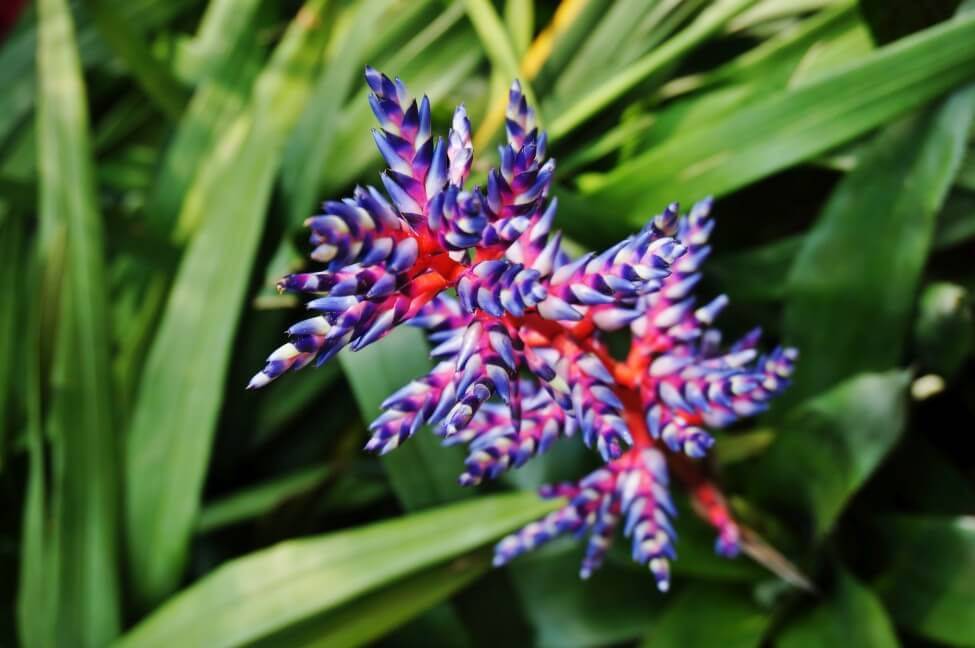
Aechmea is a genus of flower crops that belongs to the bromeliad household and incorporates about 250 species of flowering tropical crops. Bromeliads are epiphytes, which implies they develop from bushes somewhat than in soil within the floor. Nevertheless, they’ll nonetheless be cultivated indoors with the correct potting combine. All bromeliads have unique appears and tropical colours. Particularly, the Aechmea ‘Blue Rain’ Bromeliad is a hybrid that includes a strikingly stunning central blossoming spike of fiery crimson and vibrant violet blossoms. An incredible decorative purple home plant.
| GENERAL CARE: | Straightforward to develop in favorable circumstances |
| SOIL: | Properly-draining, low-moisture potting combine |
| LIGHT: | Vibrant, oblique/filtered daylight |
| TEMP & HUMIDITY: | Excessive humidity and temperatures between 65°F to 80°F |
| WATERING: | Pour tepid water via the plant’s central crown. Hold soil continually moist, however by no means soggy. |
| FEEDING: | Through the rising season, feed month-to-month with a half-strength, balanced, liquid fertilizer. |
| GROWTH: | Can attain as much as about 15 inches excessive |
| TOXICITY: | Non-toxic to pets and folks |
19. Bellflower (Campanula)
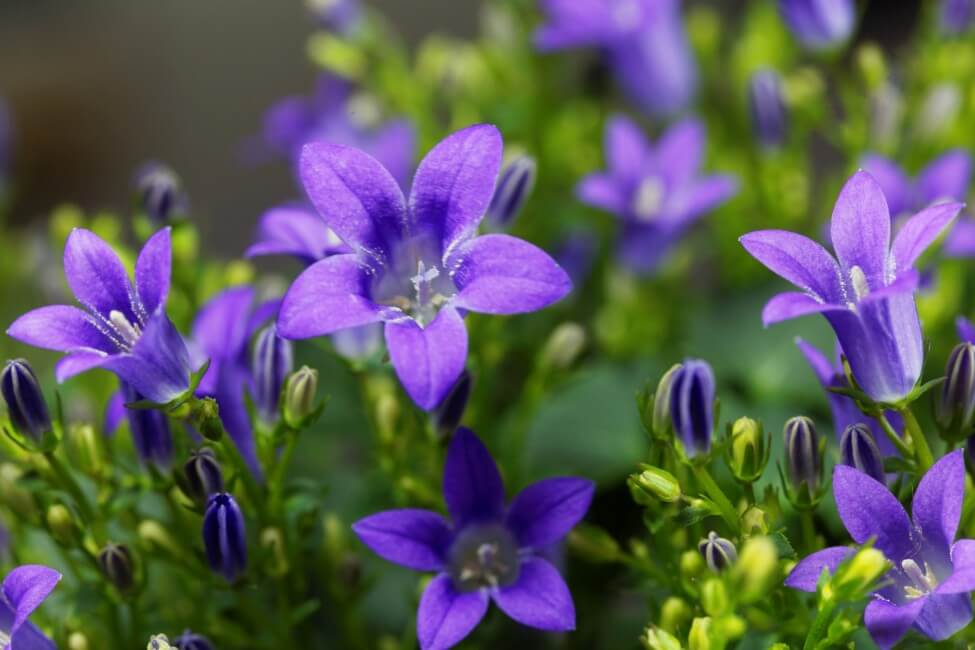
Campanula (Latin for “little bell”) is a genus of flowering crops named for the traditional bell-like form of its purplish-blue blossoms. This genus incorporates greater than 500 species and much more subspecies and hybrid cultivars of bellflowers. Outside, it’s generally cultivated for a vibrant, naturally spreading floor cowl. Nevertheless, it’s additionally fairly pretty planted in containers and may be efficiently grown indoors.
| GENERAL CARE: | Straightforward to develop in the correct circumstances |
| SOIL: | Common, well-draining soil with a pH starting from 6 to eight |
| LIGHT: | Full solar to partial shade |
| TEMP & HUMIDITY: | Temperatures between 65°F and 70°F and excessive humidity |
| WATERING: | Keep an evenly moist soil with full drainage by watering when the highest inch or two dries out. |
| FEEDING: | Fertilize as soon as in early spring with a well-balanced fertilizer |
| GROWTH: | Mature crops develop to be about 6-inches tall and 8-inches throughout |
| TOXICITY: | Non-toxic to individuals or pets |
20. Pink Quill (Wallisia cyanea)
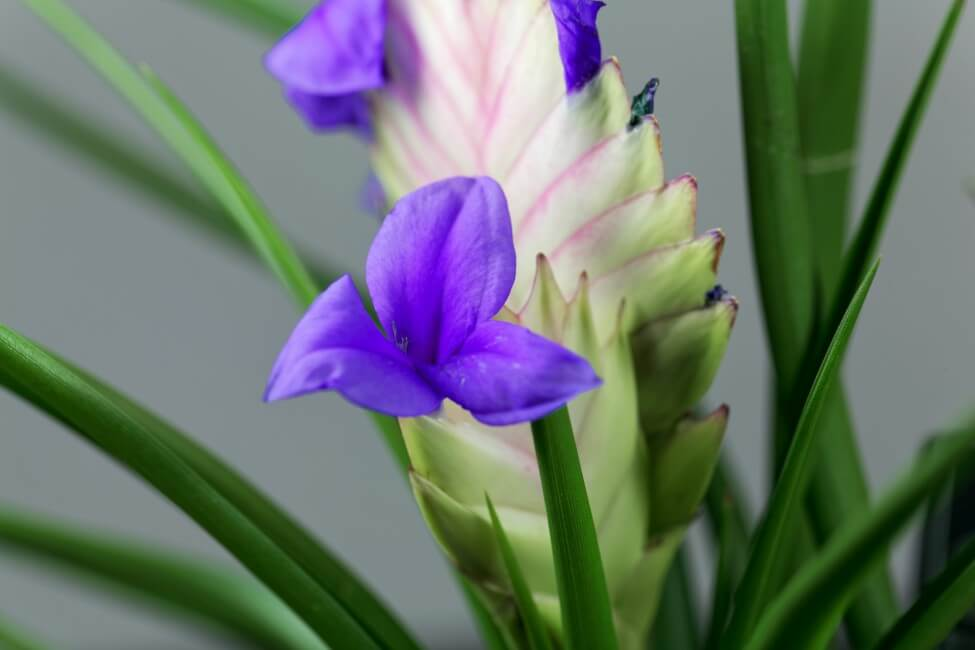
The Wallisia cyanea is a species of plant that belongs to the bromeliad household. It’s generally named pink quill in tribute to its gorgeous, light-pink, quill or feather-shaped bracts that blossom with violet flowers. These uncommon purple home crops will make an fascinating addition to any indoor gardenscape or as a person dwelling decor accent.
| GENERAL CARE: | Low-maintenance |
| SOIL: | Free potting soil blended with bark (orchid mixes or bromeliad mixes are appropriate) |
| LIGHT: | Filtered daylight to partial shade |
| TEMP & HUMIDITY: | Reasonable humidity and temperatures starting from 65°F to 75°F |
| WATERING: | Hold soil continually moist. Don’t let it dry out between waterings, however don’t enable the plant to take a seat in standing water. |
| FEEDING: | Fertilize as soon as in early spring with a well-balanced fertilizer |
| GROWTH: | Reaches as much as 12-inches tall |
| TOXICITY: | Non-toxic for individuals and pets |
Select Your Purple Houseplants with Care
When there are such a lot of purple crops to select from, it may be troublesome to slender down your search. Do not forget that it’s at all times finest to choose crops that require a stage of care you’re snug offering and a most popular setting that your own home or workplace can simply present.
Purple Home Vegetation FAQ
What crops have purple leaves?
There are quite a few crops that showcase an array of vibrant purple colours of their foliage. A few of our favourite purple crops embrace Campanula, Ti crops, Calatheas, Prayer Vegetation, Purple African Violets, darkish burgundy and purple Rubber Tree Vegetation, Moses-in-the-cradle, Gloxinia, any many sorts of succulents.
What’s the which means and symbolism of purple crops?
Historically, the colour purple represents royalty and regality. Purple can even symbolize success and emotions of admiration. Particular person purple crops and flowers have additionally taken on their very own symbolic meanings throughout cultures and religions around the globe. For instance, the purple lotus represents spirituality in Buddhist traditions, the purple violet represents prayer in Christianity, and the Chinese language evergreen symbolizes good luck.
What causes purple leaves?
Purple leaves mostly happen as a result of a pigment often called anthocyanin. This pigment absorbs each yellow and inexperienced mild into the cell construction of the foliage inflicting numerous shades of the colour purple to happen.
Why are my plant leaves turning purple?
Vegetation that don’t inherently produce purple foliage however seem like turning shades of purple (from their pure inexperienced usually) is perhaps affected by a phosphorus deficiency. This usually happens when the plant is missing in important vitamins or is uncovered to or experiencing environmental shock resembling publicity to sudden chilly temperatures.